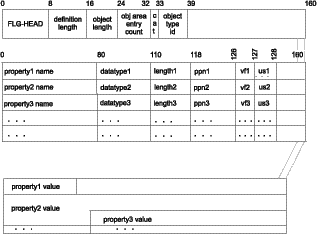
Figure 24 shows the general format of the Information Catalog Manager API output structure. The output structure consists of three contiguous areas: the header area, the definition area, and the object area. Some Information Catalog Manager API calls (for example, FLGGetType) produce only the first two areas.
When your program calls an API call that produces an output structure, it passes a pointer to a null pointer as a parameter. The API call then assigns the address of the output structure to the null pointer.
To avoid running out of memory after several API calls, your program can deallocate the memory allocated for this output structure using the Information Catalog Manager API call FLGFreeMem. For more information about FLGFreeMem, see FLGFreeMem.
Figure 24. API output structure
 |
The following API calls produce output structures to return data:
The header area describes the information in the definition and object areas. The byte-offset positions of the header area are shown in Figure 25 and described in Table 12.
Figure 25. Output structure header area
 |
Table 12. The output structure header area and its fields
| Section from Figure 25 | Byte offset | Present? | Description |
|---|---|---|---|
| FLG-HEAD | 0-7 | Always | Structure identifier. |
| definition length | 8-15 | Always | Length of the definition area.
Value is a multiple of 160 (number of properties times the length of each definition record). |
| object length | 16-23 | Always | Length of the object area.
If no data is returned, then the length of the object area is zero (00000000). |
| obj area entry count | 24-31 | Always | Number of individual property values entered in the object area.
Value is the number of properties in the definition area times the number of sets of values described in the object area. If no data is returned, then the length of the object area is zero (00000000). |
| cat | 32 | Present with:
| Category of the object type or object.
Valid values are:
|
| object type id | 33-38 | Present with:
| System-generated identifier for an object type. |
|
| 39-159 | Always | Should be left blank. |
The definition area contains a set of property definitions produced as output values by a particular Information Catalog Manager API function.
Table 13 shows the meaning of the definition area for the API calls
that produce output structures.
Table 13. The meaning of the definition area for different API calls
| API calls | Information in the definition area |
|---|---|
|
FLGGetInst FLGGetReg FLGGetType FLGDeleteTree | Definition of the set of properties that define the object registration, object type, or object instance |
| FLGInit | Information about the Information Catalog Manager environment |
|
FLGFoundIn FLGListAnchors FLGListAssociates FLGListContacts FLGListObjTypes FLGListOrphans FLGListPrograms FLGManage- CommentStatus FLGManageUsers FLGNavigate FLGSearch FLGSearchAll FLGWhereUsed | Definition of the set of properties that describe each item returned by one of these API calls |
Figure 26 shows the byte-offset positions for a record in the definition area.
Figure 26. A record in the definition area
 |
Each property in the set is defined by a set of formatted specifications,
as described in Table 14.
Table 14. The output structure definition area and its fields
| Section from Figure 26 | Byte offset | Present? | Description |
|---|---|---|---|
| property name | 0-79 | Always | External name |
| datatype | 80-109 | Always | The data type of the property.
Valid values are:
|
| length | 110-117 | Always | Maximum length of the property value in the object area. |
| ppn | 118-125 | Present with:
| Property short name |
| vf | 126 | Present with:
| Value flag specifying whether a property is required, optional, or
system-generated.
Valid values are:
|
| us | 127 | Present for the following API calls:
| Universal Unique Identifier (UUI) sequence number that specifies that a
property is part of the UUI.
Valid values are:
See the Information Catalog Manager Administration Guide for more information about UUI parts. |
|
| 128-159 | Always | Reserved section.
Is left blank. |
The object area contains the values for the properties defined in the definition area. The values appear in the order defined in the definition area.
The object area is included in the output structure for the following API calls:
FLGDeleteTree
FLGFoundIn
FLGGetInst
FLGGetReg
FLGInit
FLGListAnchors
FLGListAssociates
FLGListContacts
FLGListObjTypes
FLGListOrphans
FLGListPrograms
FLGManageCommentStatus
FLGManageUsers
FLGNavigate
FLGSearch
FLGSearchAll
FLGWhereUsed
You can determine the size of each value using the following rules: